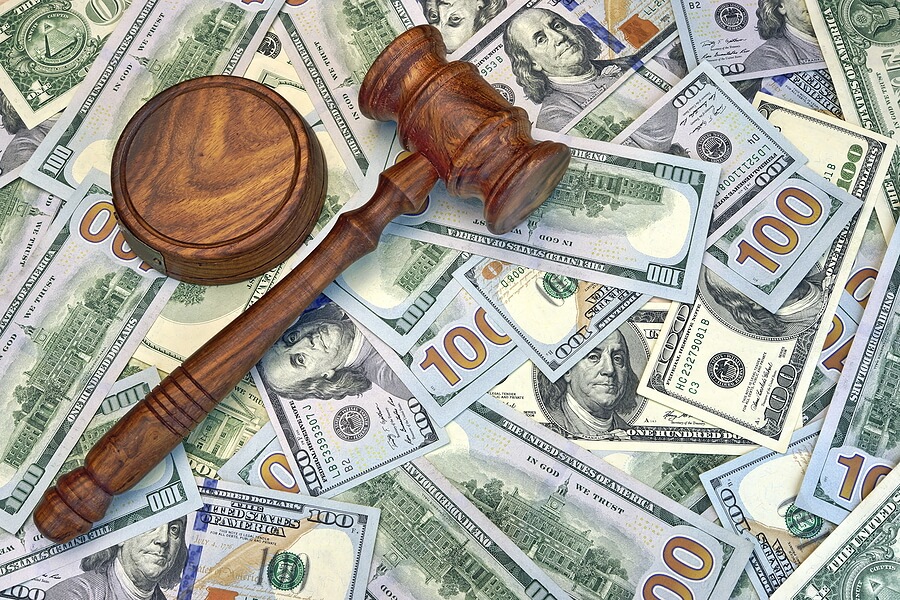As with any car accident settlement, asking how much a passenger can get is somewhat like asking how long a piece of string is. The amount a passenger can recover depends on the injuries that the passenger suffered and their lawyer can calculate it like any other recovery in a car accident. In a New York car accident case, that average verdict is well over three-quarters of a million.
That said, the median compensatory damage award in New York personal injury cases is more than a quarter of a million dollars, while the national average is closer to $35,000. Bear in mind, however, that these numbers do not control your settlement amount; your actual injuries define what you may recover.

Generally, a passenger can potentially recover from:
- The driver’s insurance company
- The at-fault driver’s insurance company
- The passenger’s personal insurance
- Any other third parties who may also have been at fault in the accident. These could include
- Those responsible for vehicle or road maintenance,
- Construction site dangers,
- Employers where one of the drivers involved was operating a commercial vehicle,
- Product manufacturers where a badly-made part may have contributed to the accident,
- Bar or restaurants that overserved one or more of the drivers,
Again, however, the actual amount of the recovery you receive will entirely depend on the amount and nature of the injuries that the passenger sustained. An experienced car accident attorney can help you understand your car accident worth with a case evaluation and guide you through the best way to maximize that claim.
Steps to Take as a Passenger After a Car Accident
If you were a passenger in a car that was in a car accident in New York, there are various steps you should take as soon as possible.
Some of these steps are:
- Collect evidence - Use your cellphone and take pictures of the scene and any damages, including your injuries, if you can. Try to get contact information from any potential witnesses.
- Gather everyone’s insurance information - The sooner you have this vital information, the sooner you can begin to file claims.
- Get and keep your medical records - You will want to be able to document all of your medical and hospital expenses. This requirement means keeping copies of all of your hospital bills, pharmacy receipts, and similar documents.
- Track your lost wages or salary - If you seek to recover for lost wages, you must be able to prove the amount of them. Copies of your older payroll records should demonstrate the amount of income you have lost.
- Notify the police - Although, as a passenger, you do not have the obligation to file a police report, it is not a bad thing for you to do so. Often the police at the scene can give you a report number for other reports that others filed. Plus, having a copy of your police report (and of any others if you can get copies) will help with filing your insurance claims.
- File a claim with the various insurance companies - An experienced Bronx car accident attorney can help you decide which insurance companies to file claims with and how to make the filings. The potential claims to be made include those with your personal insurance, the at-fault driver’s insurance, and the insurance of the driver of the car in which you were a passenger. Your attorney’s investigation of the facts of your case will decide whether to file against any particular company. As noted elsewhere, there may also be third parties who share in the liability for your injuries, and your attorney will file against them as well.
- Contact an Experienced New York Car Accident Attorney - Personal injury cases in New York can be very complicated; there are often multiple potential defendants, multiple theories of liability, and multiple kinds of damages to be recovered. Working with skilled and knowledgeable car accident attorneys can help you navigate this complex process while focusing on recovering your health and emotional stability.
New York Is a No-Fault State
Although New York is a no-fault state for auto insurance, passengers in a car accident usually fall under the at-fault driver’s Personal Injury Protection (PIP) and bodily injury liability insurance coverage. They may also have coverage from the insurance of the driver of the vehicle they were riding in, or even their own PIP insurance. Other third parties who contributed to causing the accident may also be liable.
Basic Settlement Calculation Rules
Insurance companies tend to use formulas to calculate the amount of their settlement offers. Usually, they will look at what they view as the actual calculable damages suffered by the claiming passenger and apply a multiplier to that number to figure non-economic damages like pain and suffering. That multiplier usually ranges from 1.5 to five times the actual damages, depending on the severity of the passenger’s injuries. Most awards are in the two to three times range, reserving five times for permanent and life-changing injuries.
Like any claimant in a personal injury or car accident case, a passenger must prove a duty of care, breach of the duty, and an injury to the passenger caused by the breach for which damages can be recovered. This requirement for proof would apply against the driver of the vehicle in which the passenger was riding or any of the other vehicles involved in the accident.
When Settlement Gets Tough
Some situations arise where nobody is in a hurry to settle the case, leaving the injured passenger in limbo. For example, if both drivers are at least somewhat at fault, a dispute over the respective percentages of liability can hold up the settlement or persuade them that litigation is worth the risk.
If, for instance, the prospective damages were $200,000 and a settlement would require each to pay $100,000, an insurance company that thinks its insured is only 25 percent liable may hesitate to settle in order to save $50,000. Meanwhile, the suffering and relatively helpless passenger just waits.
Settlement can also be difficult when there were multiple passengers hurt in the accident. Here the issue is not the parties’ relative liability but focuses on the finite pot of money available to settle the claims. Each insured will have a certain amount of insurance coverage. If the face amounts of the various policies exceed the apparent claims for recovery, no party will receive their full damages. If the passengers do not agree on the reduced amounts to which they may be entitled, the insurance company will not settle with any of them.
The misery caused by these thorny situations can be alleviated to a great extent by working with skilled and knowledgeable car accident attorneys. They will understand the liability issues and the funding issues and work to protect your interests. Indeed, they may even have negotiated in the past with many of these parties and be familiar with how they are likely to handle your case. In any event, an attorney can certainly reduce your stress and allow you to focus on the business of recovering your health rather than your damages.
What Damages You May Recover

Just like the driver of a car involved in an accident, passengers have the right to recover for the injuries and damages they have suffered. In New York, these damages include economic damages (out-of-pocket expenses and losses), non-economic damages (pain and suffering and similar injuries), and punitive or exemplary damages (rate and intended to punish the at-fault party). These kinds of damages include the following specifics:
Economic Damages
Economic damages are actual out-of-pocket expenses or losses that your lawyer can usually establish through documentary evidence like paid bills and invoices or payroll records.
They may include:
- Hospital and medical expenses
- Prescriptions and other drugs
- Assistive equipment
- Lost wages
- Property damage
- Bodily and mental injuries
- Reduced earning capacity
Non-Economic Damages
Non-economic damages are more subjective and less susceptible to proof than economic damages. They are harder to calculate and harder to prove. You should be aware that New York, unlike many states, does not impose a cap on non-economic damages.
Some non-economic damages are:
- Pain and suffering
- Loss of future earnings
- Future medical care
- Future rehabilitative care
- Disfigurement and scarring
- Loss of enjoyment of life
- Loss of sexual function or intimacy
- Loss of cognitive or motor functions
- Chronic pain
Punitive or Exemplary Damages
New York courts only rarely grant punitive damages. Generally, the defendant’s conduct must have been reckless or willful or wanton negligence or have indicated a conscious disregard of the rights of others. Again, New York courts only rarely grant punitive damages, often requiring that the defendant’s conduct be such as to shock the conscience of the court. New York does not cap punitive damages. Punitive damages punish the bad actor and deter others from similar conduct, not compensate or reward the injured party who receives the damages.
Common Passenger Injuries in New York Car Accidents
Although drivers are actually far more likely to be injured in a car accident than passengers, passengers who do get hurt suffer much the same kinds of injuries in car accidents as do drivers. Once only required to wear seatbelts in the front seat, from November 2020, all passengers in New York vehicles must wear a seat belt, which puts them in a similar position to the driver of the vehicle.
Common injuries in New York car accidents include:
- Traumatic brain injuries (TBIs) and concussions - Recent medical research indicates that there really are no simple or mild brain injuries. Any brain injury or concussion requires immediate medical attention since many symptoms may not appear right away and can worsen with time.
- Spinal cord injuries and paralysis - Spinal cord injuries can result in temporary or permanent paralysis from the point of injury to the spinal cord down. These injuries can result in devastating, life-changing injuries and need immediate attention.
- Back and neck injuries - Back and neck injuries may take time after an accident to manifest but can lead to lifelong pain management issues. Even whiplash can cause lifelong pain and suffering with little likelihood of recovery.
- Fractures and broken bones - From simple fractures of limbs to the severity of pelvic and hip fractures or compound and complex breaks, the injuries to your bones in a car accident can be devastating and may even require surgical repairs
- Crushing injuries - Crushing injuries can cause irreparable damages to bones and internal organs.
- Loss of digits and limbs - Crushing and other injuries to your hands, fingers, toes, and feet can result in amputation during the accident or surgically after that.
- Internal and soft tissue injuries - Internal injuries can completely destroy bodily organs and may require their removal. Sometimes these injuries lead to lifelong changes in lifestyle, but they can also result in death.
- Burns and scarring - Burns are horrifically painful and, in a car accident, can cover large portions of the body, leading to a long-term slow and painful recovery. Not only that, but the scarring left behind by burns can lead to disfigurement and cause extreme emotional damage, especially to younger victims.
- Emotional injuries, including PTSD - Emotional injuries in a car accident can be neurological if they result from TBIs or other physical damage to the brain. They can also be emotional if they result from traumatic life changes due to injuries or scarring. In either case, the extensive treatment needed will be expensive and take much time.

How a Car Accident Attorney Can Help
If you or a loved one suffered an injury in a car accident as a passenger in New York, a skilled and knowledgeable car accident attorney can help you navigate the complexities of New York’s recovery laws and help you to obtain the best possible settlement for you. Contact a trusted car accident law firm for an initial consultation and case evaluation at no cost to you. Let us examine your case and determine whether we can relieve you of the stress and burdens of trying to deal with it all on your own.



